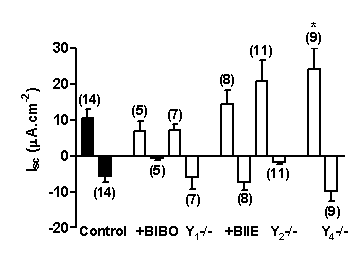| pA2 online © Copyright 2004 The British Pharmacological Society |
150P
GKT, University of London Winter Meeting December 2003 |
|
Capsaicin-induced
changes in ion transport across colonic mucosae are unaffected by
neuropeptide y Y1 or Y2
antagonism or Y1, Y2
or Y4 receptor knockout |
|
Capsaicin, the pungent ingredient in red peppers of the genus Capsicum, activates type 1 vanilloid receptors (VR1) causing substance P release from sensory and secretomotor neurones within the lamina propria of the intestine (McVey & Vigna, 2001; Poonychoti et al. 2002). SP in turn stimulates a rapid, transient NK1 receptor-mediated increase in epithelial ion transport that is rapidly desensitising and capsazepine-sensitive (Yarrow et al., 1991; Cox et al., unpublished data). A slower inhibitory effect is also observed in rat and mouse colon and this component is not SP-mediated. Our aim was to establish whether neuropeptide Y (NPY) mediated the inhibitory phase or modulated the biphasic capsaicin response in mouse colon, using selective antagonists for the Y1 (BIBO3304) or Y2 (BIIE0246) receptors as well as knockout mice lacking either Y1 , Y2 or Y4 receptors.
Descending colon mucosae from wild type (+/+) and knockout (Y1 -/-, Y2 -/-, Y4 -/-,) adult mice (>12 weeks of age, either sex and mixed genetic background; C57/Bl6-129Sv) were voltage-clamped at 0 mV in Ussing chambers as described previously (Cox et al. 2001). Tissues were allowed to reach a stable basal short-circuit current (Isc ) before basolateral addition of Y receptor antagonist (300nM BIBO3304 or 1µM BIIE0246) or vehicle (0.01% DMSO) 15 min prior to capsaicin (1µM) addition. Responses to vasoactive intestinal polypeptide (VIP, 30nM) and carbachol (10 µM) were also recorded. Peak changes in these and each phase of the capsaicin response were pooled and values (mean ± 1 s.e.mean) were compared using a one-way ANOVA with Dunnett`s post-test.
The basal Isc values for wild type and knockout tissues were not significantly different (data not shown) but VIP responses were significantly increased in Y4 -/- (98.85±6.8µA.cm-2, n=30, Y4 +/+ compared to 147.2±10.8mA.cm-2, n=30, Y4 -/-, P<0.001).
Fig. 1. The effect of Y antagonists (BIBO3304 or BIIE0246) and Y1 , Y2 or Y4 receptor knockout on capsaicin responses.

We conclude that neither Y1 nor Y2 receptors modulate capsaicin-induced responses in isolated colonic mucosa. In Y4 -/- tissue however, a significantly larger capsaicin-induced increase in Isc was observed. Since VIP responses were also significantly enhanced in these tissues, we conclude that the Y4 receptor has no specific modulatory effect upon VR4-mediated responses in the mouse colon mucosa.